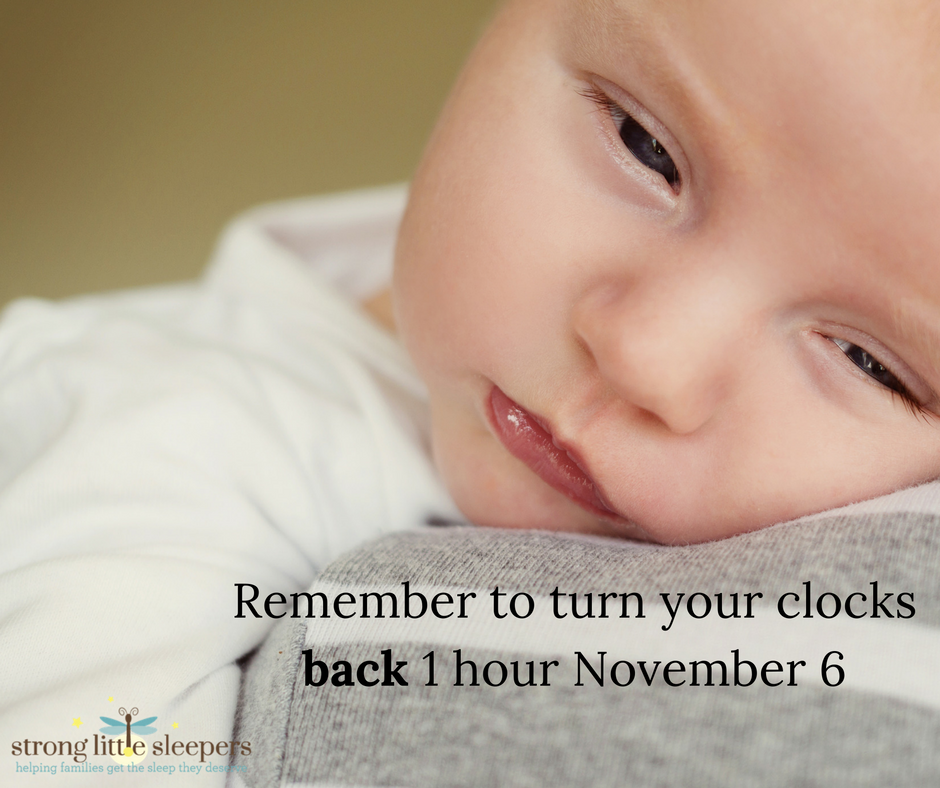The fall time change occurs on Sunday November 1 when Daylight Saving Time officially ends at 2:00 am. While many of us relish the “extra hour” of sleep this gives, the time change can completely throw off the sleep schedules of babies, toddlers, and small children, whose internal clocks don’t shift with the push of a button. Without a proper Daylight Saving Time sleep plan, the day is going to start a whole hour earlier than normal for these families.
So the best way to get yourself and your kids adjusted to the new time schedule is to have a plan in place beforehand, and be ready to adjust as needed. Here are three ways to help you and your children fall back with ease during this time change:
1. Prepare ahead of time.
If you have a child who is sleep sensitive and doesn’t do well with change in environment or schedule, help them by doing a gradual “fall back” instead of all at once. Starting 4-5 days ahead of time, push dinner time, bedtime routine, bedtime, and wake-up time ahead 15 minutes each day. For example, Susie usually eats dinner at 5:00, is in bed by 7:00, and wakes up at 6:00 the next morning. On Wednesday, November 2, she’s going to eat dinner at 5:15, be in bed by 7:15, and wake up at 6:15. On Thursday, dinner will begin at 5:30 with a bedtime of 7:30, Friday bedtime will be at 7:45, and Saturday will be at 8:00. Then on Sunday morning, VOILA! She’s waking up at her regular 6:00 am after the time change! This method takes some commitment to those days leading up, but allows for a quicker adjustment period after the time change happens.
2. Just go with the fall.
The majority of children do fine adjusting within 3 or 4 days, maybe a week, and for most of us we don’t need to do anything more than to adjust naturally. So when you turn your clocks back Sunday morning just go with the new time: nap at new time, dinner, bedtime routine, and bedtime at new time. The only caveat to this method is your child may exhibit tired cues before nap or bedtime. If this happens you can do a slightly earlier bedtime for a couple days while their body is adjusting to the new time. As they adjust things will get much easier and they’ll be able to go to bed a their normal bedtime.
3. Light the way.
Use exposure to light as your assistant. One of the things that helps our bodies adjust to time change is regulating the input of light that our brains receive. When we feel tired in the evening we want to adjust by exposing our brains to bright light, and when we want more sleep in the morning we keep the blinds closed and stay in the dark. In order to keep our kids up until their normal bedtime, expose them to brighter light during the evening hours. Then if your child is waking up earlier in the morning, encourage their body to stay sleepy by keeping the lights low in your home until it’s time to start the day. Your home lighting schedule can be a great tool in adjusting to the new time change.
With these tips you can get your plan in place, and you should be able to adjust your children and yourself to the time change within 3 or 4 days, a week at the most.
May you “fall back” with ease!
If other sleep issues are occurring it may be hard to make these changes smoothly. That’s when it’s beneficial to have a sleep consultation to talk these out in a more personal manners, and that’s why I’m here and ready to help! Contact me for help, and we’ll get your little one sleeping soundly and happily.
 Strong Little Sleepers
Strong Little Sleepers
Lori is a Certified Child Sleep Consultant through and Certified Happiest Baby Educator. She is the founder and owner of Strong Little Sleepers, which was started on the idea that all families need and deserve to get a good night’s sleep. Lori was the first certified child sleep consultant in Austin, Texas and was honored as Best Sleep Expert in the 2013 and 2019 Austin Birth Awards. She is also a member of the International Association of Child Sleep Consultants. Lori combines her experience as an educator and a parent to offer customized sleep plans and support to families with children ages 0-6 across the country.
For more information, please visit www.stronglittlesleepers.com.
Interested in writing a guest blog for Strong Little Sleepers? Send your topic idea to pr@stronglittlesleepers.com.

